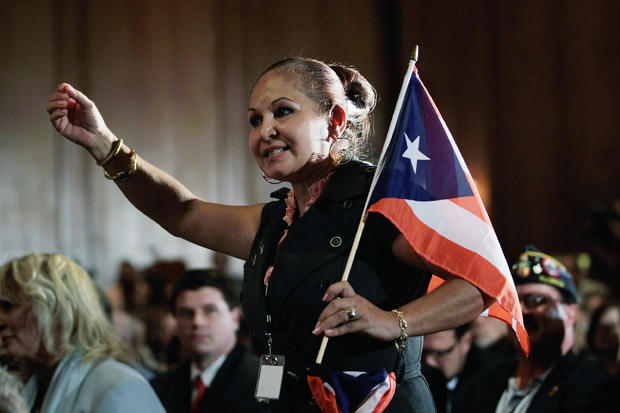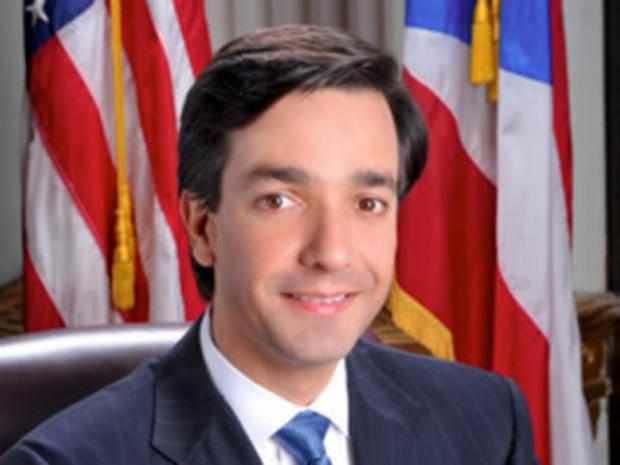Puerto Ricans' electoral impact grows in Florida
KISSIMMEE, Fla. - Madeline Ortiz moved here a decade ago from Puerto Rico, part of a tidal wave of Puerto Ricans who have relocated to an area once dotted with cattle farms. They were drawn by promises of good weather, low crime rates and jobs at Walt Disney World and the other theme parks in nearby Orlando.
Plus, the housing was relatively cheap: In 1978, a company called Landstar Homes started building thousands of houses in the area, which it marketed in Puerto Rico and Puerto Rican communities in New York. Today, what was once a rural county is dotted with tract-housing subdivisions and main streets on which the local Century 21 office features a sign reading, "agents needed - bilingual a plus." Osceola County, which encompasses Kissimmee, is now 46 percent Latino and rising, and most of the Latino population is Puerto Rican.
Ortiz, a nurse, came to the area when Jeb Bush was governor. She likes Bush, who has been at the forefront of an effort to convince Republicans to better reach out to Latino voters. A generation ago, the civil rights fight pushed African-Americans into the arms of Democrats; more recently, the GOP's immigration rhetoric has prompted Latinos, a fast-growing voting bloc that will help decide this swing state and others, to rally behind President Obama. Yet while it may already be too late for Republicans to turn the tide with Mexican-Americans and many other Latino groups, Puerto Ricans are a different story.
Since they hail from a U.S. territory, Puerto Ricans are less likely to be chose sides based on immigration policy. And while they tend to support Democrats, voters in Puerto Rico elected a conservative Republican governor in Luis Fortuno, who was given a prominent speaking spot at the Republican National Convention. (While Puerto Rico has no say in the general election, Puerto Ricans can vote in presidential elections soon after relocating to the states.)
Ortiz, who backed President Obama in 2008, says she doesn't yet know who she's going to vote for this year. A Medicare recipient who is fighting cancer, she says she is concerned about the future of the health care program and complains that Republican presidential candidate Mitt Romney "doesn't really have anything concrete to say about it." But when she talks about the federal health care law championed by the president, she compares it to socialism.
"Everyone is going to have insurance in the whole country," she said. "Good. That's good. But what about the taxes? Who's going to pay for it?"
The political map of Florida is relatively simple: The panhandle in the north votes Republican by a wide margin, while the southern part of the state (with the exception of Miami's Cuban population) swings Democrat. The battle for the state's 29 electoral votes is largely fought here in the middle, in the area known as the I-4 corridor, where 43 percent of all Florida voters live. Anchored by Tampa and Orlando, it is the largest swing area of the largest swing state, which is why Republicans held their nominating convention in Tampa despite the risk of a hurricane. On Wednesday, Bill Clinton is scheduled to hold a "grassroots event" in Orlando to drum up support for the president. And next week, both candidates are expected to hold campaign events in Tampa, though public events have not been announced.
Florida is nothing if not a swing state: There have been five presidential elections here since 1992, with two going to the Democrats, two to the Republicans, and one resulting in that epic mess in 2000. Over those five races, 32.5 million votes have been cast for president in Florida -- and the difference between the parties in total votes is just .017 percent.
The demographic shift toward a larger Latino population would seem to favor the Democrats. Latinos now make up 23 percent of the state's population - up from 17 percent a decade ago - though they currently make up just 13.1 percent of the electorate. (While right-leaning Cubans are still the largest Latino population in the state, at 6.4 percent of the state population, Puerto Ricans are on pace to eclipse them.)
But voters in the I-4 corridor aligned to a party are almost evenly split between the Republicans and Democrats, and they are very much up for grabs. Osceola County narrowly backed George W. Bush in 2004, and then went to Mr. Obama in 2008. In 2010, the county went to Cuban-American Republican senator Marco Rubio.
One of the frustrations for both parties in courting the region's growing Puerto Rican population is that while voter turnout in Puerto Rico is exceedingly high, Puerto Ricans are far less likely to vote once they leave the island. That can be explained in part by the fact that transplants simply do not engage with American politics in the same way they do on the island, where political engagement is embedded in the culture.
Outside a Wal-Mart in the heavily Puerto Rican neighborhood of Buenaventura Lakes, a half-hour drive from Disney World, most residents declined to offer views on the presidential candidates, with many stating simply that they aren't paying attention. One exception was customer service agent Jessica Alonso, who was born in New York and lived in Puerto Rico before moving to Florida. She plans to vote for the president. "We haven't heard Romney offering a lot of things for Latinos," said Alonso.
In addition to winning the I-4 corridor, the two campaigns are focused on driving up turnout among their base (for Mr. Obama, that's young voters as well as African-Americans, who make up 16.5 percent of the state's population) while winning the hearts of seniors, who broke for Sen. John McCain in 2008. Floridians who are 65 or older make up nearly 18 percent of the state's population, and they tend to vote in high numbers; both candidates are seeking to win over older votes by casting the other candidate as hostile to Medicare. (There's also a pair of wildcards in Florida's GOP-led efforts to purge voter rolls of non-citizens and curtail early voting, both of which are expected to benefit Republicans.)
Ultimately, however, most observers believe that the most important factor in deciding the Sunshine State will be the same that will decide many other swing states: The condition of the economy. The unemployment rate in Florida is 8.8 percent, above the national average, though down from a high of 11.4 percent in January 2010. While Florida's unpopular Republican Gov. Rick Scott has, somewhat awkwardly for Romney, been promoting his state's economic improvement in recent years, a drive through Kissimmee reveals how bad things remain: The streets are dotted with pawn shops and single occupancy rooms offering weekly rates for residents down on their luck.
Polls show the race effectively split, but Mr. Obama's approval rating is "like a Florida mortgage - he's underwater," in the words of Aubrey Jewett, a professor of political science at the University of Central Florida and co-author of "Politics in Florida."
"The way people feel about the economy - a lot of political scientists think that's more important than the actual statistics," said Jewett. "I've been here since '86. For the better part of 20 years, we outperformed the national economy. Our job market was stronger, our economy was stronger. But now, as of 2006 or so, it just seems even worse to us, because we've gone from outperforming to underperforming. We're below the national average on nearly every single measure."


